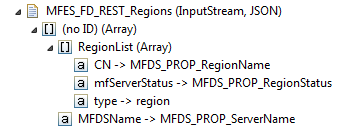GET Service
Function:
The tool GET provides support for you to execute a HTTP GET request on a Web application to get resources from a Web application.
Tool Attribute:
| Attribute | Type | Description |
|---|---|---|
| Media Type [M] | Selection | Specifies the media type that is acceptable for the response. Valid values are
Note: If the accepted media type is specified via a Request Header with the key "Accept" , the header value has preference. See also: HTTPS://WWW.W3.ORG/PROTOCOLS/RFC2616/RFC2616-SEC14.HTML#SEC14.1 |
| Response Body Resource Processing [O] | Selection | Specifies what type of resource operation should be executed based on the returned response body.
The resource operation will use all properties mapped in the referenced response body output parameter file descriptor. This is optional, since not all resource operation types require property values to be successfully executed (e.g. DELETE will remove the selected element even if no element ID properties are specified). Possible values:
For more information on resource processing, see Tool Descriptor Note: The Resource Processing attribute of the tool descriptor must be set to “TOOL_DEFINED” in order for the resource operation to be processed. |
Example
A GET request for obtaining information about a project entry with Response Body Resource Processing set to UPDATE will refresh the property values of a selected project entry.
Parameters:
| Parameter Name | I/O | Type | Description |
|---|---|---|---|
| URL [M] | I | String | URL to the GET service of the Web application |
| Realm [O] | I | String | Realm enables mapping between client application and Web application. It is only relevant if an AWM application addresses different Web applications. |
| Request Body [M] | I | File | File containing the get payload as expected by the Web application. |
| Response Body * [O] | O | File | File containing the get response sent from the server application. |
| Response Code [O] | O | String | Response Code returned by the server application. |
| Response Header * [O] | O | String | Reference to a response header field of the HTTP GET request. |
Additional Parameter Attributes:
| Parameter Name | Attribute | Description |
|---|---|---|
| URL | Query Encoding | Charset used to encode the URL. |
| Query Separator Symbol | Symbol used to separate query parameters within the URL string. | |
| Response Body | Status Code | Status code which can be intercepted by a custom error handling. Note: Specified as a regular expression. |
| Response Header | Name | Name of the response header field. |
Relationship: REST Tool Has Request Header
The relationship REST Tool Has Request Header enables you to specify a name/value pair to be sent in the HTTP request header.
If specified in an authentication request the name/value pair is sent with every HTTP request for the signed in session.
| Attribute | Type | Description |
|---|---|---|
| Name | String | Name of the HTTP header field. |
| Value | String | Value of the HTTP header field. |
Relationship: URL Has Query Parameter
The relationship URL has Query Parameter that enables you to specify parameters in the form of name/value pairs to be added to the HTTP request.
| Attribute | Type | Description |
|---|---|---|
| Name | String | Name of the query parameter. |
| Value | String | Value of the query parameter. |
Example
The following example shows a tool that gets the regions of an Enterprise Server:

The file descriptor that describes the response body can be modelled as follows:
